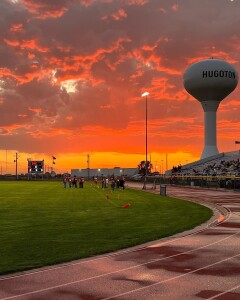Working in close cooperation, civilian firefighters and Kansas National Guard air crews made significant progress in battling south central Kansas wildfires over the past few days. Four Stevens County volunteers contributed their efforts to fight the fire. Rodney Kelling of Hugoton and Greg Sohm of Rolla were deployed as members of the state incident management team, while Bailey Esarey and Mike Milhon were deployed as firefighters. Rodney served five days, Greg volunteered for four, and both Bailey and Mike fought the fire for two days. Saturday, four UH-60 Black Hawk helicopters piloted and crewed by Soldiers with 1st Battalion, 108th Aviation Regiment of the Kansas National Guard arrived to assist in fighting the fires.
The Black Hawks, each equipped with a 660 gallon Bambi Bucket®, ferried water from local water sources to dump on the flames, as directed by incident management officials. Crews made 68 drops Saturday and another 56 Sunday, totaling approximately 68,000 gallons of water. The crews returned to their home stations in Topeka and Salina Sunday evening.
As of Monday, Barber County officials reported the fire at 81 percent containment, an improvement from 31 percent containment Sunday, and 15 percent Saturday. Estimates indicate approximately 300,000 acres total burned in Kansas, more than 270,000 acres in Barber County alone.
No injuries or fatalities have been reported as a result of the fires, but 12 homes have been destroyed-nine in Barber County, two in Reno County and one in Harvey County-along with multiple outbuildings and an unknown number of livestock have been lost. Three bridges and one railroad trestle have also been damaged or destroyed. Damage assessments are just beginning, so totals are expected to change.
Barber, Comanche, Harvey and Reno Counties issued state of local disaster emergency declarations and Governor Sam Brownback authorized a State of Disaster Emergency declaration March 23 for all four counties. The state requested and was granted a federal Fire Management Assistance Grant for Barber and Comanche Counties.
Firefighters, aided by rain and snow in the region, have made significant headway in controlling the Anderson Creek Fire in Barber and Comanche counties. Farm, ranch and industry organizations including Kansas Farm Bureau and the Kansas Livestock Association are focusing their efforts on how to assist farmers and ranchers who have been affected by the largest wildfire in Kansas history.
The fire has burned approximately 300,000 acres in southcentral Kansas, taking numerous homes, outbuildings, many miles of fence and an unknown number of cattle. Most fences were destroyed in the fire, leaving wire lying on the ground where wooden posts were burned. Ranchers in the area continue tending to the feed and health needs of surviving cattle, many of whom are suffering from respiratory problems due to smoke inhalation, according to producers and veterinarians. Some were directly injured by fire.
Kansas Farm Bureau has created a fire relief site for those impacted and those willing to help. The site, www.kfb.org/firerelief, will connect those donating supplies like fencing, building materials and labor to those in need. This site will enable Farm Bureau to help ensure the resources can be implemented efficiently. Local contacts include Jennifer Theurer in Comanche County, who can be reached at 620-440-9059, and Zel Polf in Barber County, whose contact number is 620-886-3316. Contacts at Kansas Farm Bureau include Nancy Brown, 785-587-6111, and Serita Blankenship, 785-587-6150.
Anyone wishing to make direct contributions to the Kansas Farm Bureau Foundation may send them to Kansas Farm Bureau, 2627 KFB Plaza, Manhattan, KS 66503, with “fire relief efforts” noted in the memo. All funds collected will be split between impacted counties as directed by county Farm Bureaus.
The Kansas Livestock Association (KLA) has also been working to assist in relief efforts. Donations to the Kansas Livestock Foundation (KLF) will help to meet the needs of ranchers affected by the wildfire. Funds generated will be used for fencing supplies, animal health efforts and other needs identified by KLA leadership in Barber and Comanche counties. Donations are tax deductible and can be sent to KLF at 6031 S.W. 37th, Topeka, KS 66614. Specify the check is for “disaster relief” in the memo line. Online contributions can be made at http://www.kla.org/dona tionform.aspx.
Several members are generously donating proceeds from the sale of animals to KLF for disaster relief. A heifer donated by KLA President Elect David Clawson and Clawson Ranch Partnership will be sold Thursday, March 31 at Pratt Livestock to generate funds for the relief effort through KLF. The heifer will be re-sold several times. In addition, KW Cattle Company plans to donate proceeds to KLF from the sale of lot 21, an Angus bull. The bull sold Tuesday, March 29 at the KW sale near Fort Scott.
Submitted by The Adjutant General’s Department and Department of Agriculture.



